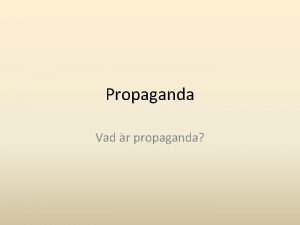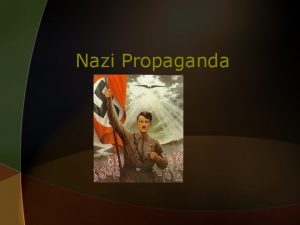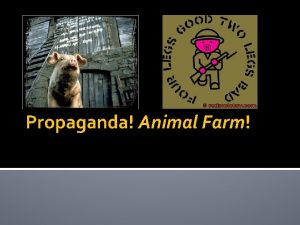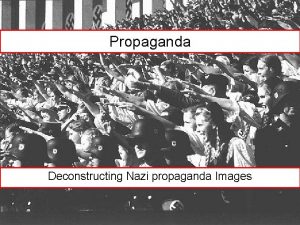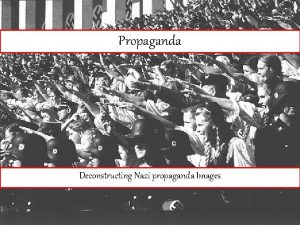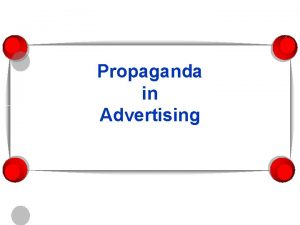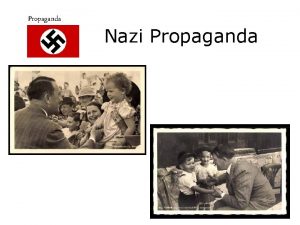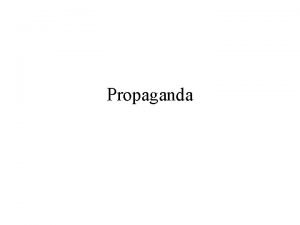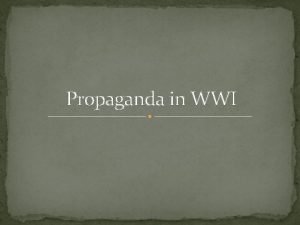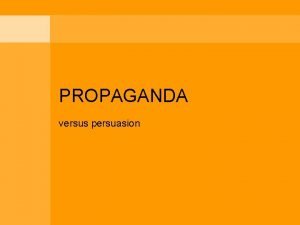The Value of War Propaganda In war propaganda
















- Slides: 16


The Value of War Propaganda In war, propaganda can be seen as an instrument for maintaining unity, goodwill and a common purpose. For the several million Allied soldiers assembled on the battlefield from 1914 to 1918 it served to strengthen and maintain morale. At home it helped to unify society. Through suggestion and persuasion it mobilized the work force to support and fuel the war effort. Propaganda was essentially a selling job and the use of the poster to raise money suited the purpose well.

During the First World War poster design and production was controlled through government agencies such as: - the Parliament Recruitment Committee in Britain - the Division of Pictorial Publicity in the United States - Victory Loan Dominion Publicity Committee in Canada. Posters were generally large, and printed on poor quality paper in large quantities; 500, 000 for the American “That Liberty Shall Not Perish From The Earth” and 65, 000 for the Canadian “Victory Bonds Will Help Stop This”.


The real horrors of war were generally avoided in posters, but commonly recognized symbols like the spiked helmet and German eagle were used as identifiers. At the same time the flag, the Statue of Liberty and ethnic humour glorified the Allies. In addition, the symbolic use of women portrayed as victims was particularly effective.



In the attempt to sell the war, Allied propaganda art made particular use of the image of the soldier. From bedraggled defender of civilization (for example, On Ne Passe Pas!) to hero (for example On Les Aura!), the Allied soldier always did his duty despite hardships and his efforts were rewarded with victory.


The Allied soldier always did his duty despite hardships and his efforts were rewarded with victory.

As with victory bonds a similar image which implored the viewer to save food was used: We are Saving You. This was employed in Canada to promote a national thrift campaign.

Mounting casualties required female presence on the front, consequently, the poster image of women shifted from one of women as victims to a more positive one as care givers. The Greatest Mother in the World is a particularly evocative poster in its purposeful similarity to Michelangelo's Pietá, the classical sculpture of Mary with the body of Christ.

Destroying the enemy from the home-front perspective was euphemistically referred to as "finishing the job".

As the war was drawing to a close, bringing back and re-establishing the veterans were the duties of civilians who stayed behind.

At 11: 00 A. M. November 11, 1918, there was peace on the battlefield, but the Poster War continued.

The Provincial Museum of Alberta 780 -453 -9100 12845 -102 Avenue, Edmonton, T 5 N 0 M 6 Copyright © 1999, The Provincial Museum of Alberta URL: http: //www. pma. edmonton. ab. ca
 Value creation value delivery value capture
Value creation value delivery value capture Hát kết hợp bộ gõ cơ thể
Hát kết hợp bộ gõ cơ thể Frameset trong html5
Frameset trong html5 Bổ thể
Bổ thể Tỉ lệ cơ thể trẻ em
Tỉ lệ cơ thể trẻ em Chó sói
Chó sói Thang điểm glasgow
Thang điểm glasgow Bài hát chúa yêu trần thế alleluia
Bài hát chúa yêu trần thế alleluia Môn thể thao bắt đầu bằng chữ đua
Môn thể thao bắt đầu bằng chữ đua Thế nào là hệ số cao nhất
Thế nào là hệ số cao nhất Các châu lục và đại dương trên thế giới
Các châu lục và đại dương trên thế giới Công thức tính thế năng
Công thức tính thế năng Trời xanh đây là của chúng ta thể thơ
Trời xanh đây là của chúng ta thể thơ Cách giải mật thư tọa độ
Cách giải mật thư tọa độ Phép trừ bù
Phép trừ bù độ dài liên kết
độ dài liên kết Các châu lục và đại dương trên thế giới
Các châu lục và đại dương trên thế giới

















